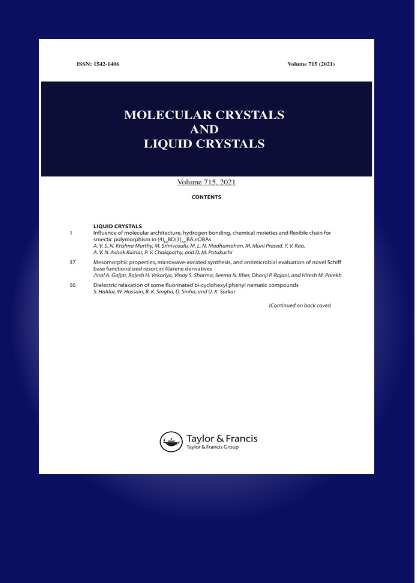α, ω-二羧酸和烷基氧基苯甲酸衍生氢键液晶配合物(HBLC)的设计、合成、实验和理论研究
IF 0.7
4区 化学
Q4 CHEMISTRY, MULTIDISCIPLINARY
引用次数: 0
摘要
摘要采用非介生(α, ω-二羧酸)2,2 -二甲基琥珀酸(DMSA)与液晶4-n-烷基氧基苯甲酸(nOBA, n = 7 ~ 12)结合制备了新型氢键液晶(HBLC)配合物。用偏光显微镜(POM)和差示扫描量热仪(DSC)分析了所有配合物的介观行为。采用场发射扫描电镜(FE-SEM)观察了DMSA + 11OBA HBLC配合物的微观结构。优化了DMSA + 7OBA HBLC配合物的分子几何结构。利用实验和理论的傅里叶变换红外光谱(FTIR)证实了配合物的分子间氢键。自然成键轨道(NBO)研究支持氢键的存在。关键字:DFT计算hblcmep分析pomsm C致谢作者之一V.N. Vijayakumar感谢UGC-DAE的财政支持,CSR-CRS/2022-23/04/887,日期:2023年5月15日,科学技术部(No. 5)。塞尔维亚/F/7454/2013-2014,日期为2014年2月21日),新德里,原子能部(No. 34/14/14/2016-BRNS/34039,日期为2016年4月22日),核科学研究委员会(大brns), TNSCST/RFRS/VR/19/2018-2019/7666,日期为2019年6月6日,TNSCST/RFRS/PS/VR/09/2020-2021/Dtd:27.04.2023,以及由班纳里安曼理工学院提供的基础设施支持。我们感谢印度新德里巴拉蒂亚大学核磁共振研究所,由印度科学技术研究院(PURSE二期项目)支持。作者感谢Bannari Amman理工学院化学系副教授R. Jayaprakasam博士(Rtd)一直以来的支持。披露声明作者未报告潜在的利益冲突。其他资料资助本研究由大学教育资助委员会教资会- dae科学研究联会资助。本文章由计算机程序翻译,如有差异,请以英文原文为准。
Design, synthesis, experimental and theoretical studies on hydrogen bond liquid crystal complexes (HBLC) derived from α, ω-dicarboxylic acid and alkyloxy benzoic acids
AbstractNovel hydrogen bond liquid crystal (HBLC) complexes are prepared from the combination of non-mesogenic (α, ω-dicarboxylic acid) 2, 2-Dimethylsuccinic acid (DMSA) and liquid crystalline 4-n-alkyloxybenzoic acids (nOBA, n = 7 to 12). Mesogenic behavior of all complexes is analyzed by polarized optical microscope (POM) along with their thermal properties using differential scanning calorimeter (DSC). The microstructure of DMSA + 11OBA HBLC complex is observed by Field emission-scanning electron microscope (FE-SEM). The molecular geometry of DMSA + 7OBA HBLC complex is optimized. Intermolecular H-bonding of complexes is evinced using experimental and theoretical Fourier transform infrared spectroscopy (FTIR). Natural bonding orbitals (NBO) study supported the occurrence of H-bonds.Keywords: DFT calculationHBLCMEP analysisPOMSm C AcknowledgmentsOne of the authors, V.N. Vijayakumar, acknowledges the financial support of the UGC-DAE, CSR-CRS/2022-23/04/887 dated15.05.2023, Department of Science and Technology (No. SERB/F/7454/2013-2014, dated February 21, 2014), New Delhi, and the Department of Atomic Energy (No. 34/14/14/2016-BRNS/34039, dated April 22, 2016), the Board of Research in Nuclear Science (DAE-BRNS), TNSCST/RFRS/VR/19/2018-2019/7666, dated June 6, 2019, TNSCST/RFRS/PS/VR/09/2020-2021/Dtd:27.04.2023 and infrastructural support provided by the Bannari Amman Institute of Technology, Sathyamangalam. We acknowledge NMR facility, CIC, Bharathiar University supported by DST (PURSE Phase II programme), New Delhi. The authors are grateful to Dr. R. Jayaprakasam (Rtd), Associate Professor, Department of Chemistry, Bannari Amman Institute of Technology, Sathyamangalam for his constant support.Disclosure statementNo potential conflict of interest was reported by the author(s).Additional informationFundingThis work was supported by UGC-DAE Consortium for Scientific Research, University Grants Commission.
求助全文
通过发布文献求助,成功后即可免费获取论文全文。
去求助
来源期刊
CiteScore
1.20
自引率
14.30%
发文量
248
审稿时长
2 months
期刊介绍:
Established in 1966, Molecular Crystals and Liquid Crystals is a world-leading journal publishing original research papers in both an experimental and theoretical nature in three areas of specialization: liquid crystals, molecular crystals, and low-dimensional solids. These cover, but are not limited to:
Liquid Crystals:
-Electro- and magneto-optical phenomena; thermodynamics; phase transitions; structure; NMR and orientation-controlled spectroscopy; theory.
Molecular Crystals:
-Spectroscopy; energy and charge transfer; solid state reactions; photo and radiation effects
Low-dimensional Solids:
-Structure, electronic, magnetic, and optical properties; transport mechanisms
The journal publishes research papers, review papers, and book reviews. In all three areas, experimental manuscripts describing both preparation and properties will be considered. Papers that describe determination of crystal structure alone are not encouraged unless some solid state forces (hydrogen bonding, charge transfer, etc.) are playing a significant role and/or some solid state properties of the materials are measured.

 求助内容:
求助内容: 应助结果提醒方式:
应助结果提醒方式:


